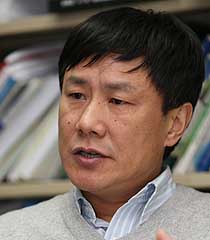| After rebounding sharply from a nadir in late 2008, China's economy is approaching a crossroads. Government-led investments effectively compensated for plunging exports while consumption has yet to play a more prominent role. How should the country proceed with the restructuring process and what is the major stumbling block? What other risks lie ahead on the path to recovery? Beijing Review interviewed three economists and experts to get their insights about these issues.
Derek Scissors: Two Paths in Sight
|

|
|
COURTESY OF DEREK SCISSORS Derek Scissors is a research fellow for Asia Economic Policy at The Heritage Foundation's Asian Studies Center | Despite a strong rebound in China's GDP in the first half of this year, I do not think the country's economic performance is healthy. That assessment relies on another figure—loan growth. Bank lending expanded 34 percent in the first half, which is far too much in any context. While the speed of lending has doubled, the economy has slowed. More loans are being provided but the return on projects is declining, so that repayment of these loans is in doubt. China has stimulated faster growth in the second quarter, and perhaps the third, but at the cost of severely damaging the banking system. There may be some official denial of this, but 34-percent lending growth and 7.1-percent GDP growth automatically imply many failed loans.
If China could make a smooth transition to rebalance its economy, the Central Government would have long ago initiated it. The State Council has been calling for consumption to become more important in the economy since 2003. Instead, the share of consumption in GDP has dropped. This is because it will be quite difficult to rebalance.
It is not a surprise, then, that the first-half economic indicators show no progress toward rebalancing. No matter how investment and consumption are measured, investment is expanding far more quickly. China is becoming more investment-dependent. Bank loans are being made almost entirely by state banks and predominantly to state firms for the purpose of maintaining or increasing production. These critical features of the economy are unchanged from before the crisis.
China's former premier Zhu Rongji's actions in the mid and late 1990s provide a historical example of true restructuring—both its advantages and its costs. At this time, there are two paths of rebalancing, both involving credit. The first involves a temporary period of high unemployment. If bank lending is reduced and redirected from firms to consumers, production will fall and jobs will be lost. But consumption will rise and, eventually, jobs will be created to meet the new pattern of consumer-led expansion.
The second path involves sharply reducing state control of the economy. If non-state banks are permitted to claim a far larger market share, non-state firms and consumers will receive much more credit. The extension of credit to consumers will have the same effect as in the first path. The extension of credit to non-state firms will increase competition, thus reducing the price of goods and services, and minimize the distortions caused by provision of land and capital to state enterprises.
Zhang Yansheng: A Matter of Time
 |
|
COURTESY OF ZHANG YANSHENG Zhang Yansheng is an economist with the Academy of Macroeconomic Research under the National Development and Reform Commission | Coming off a virtual standstill in late 2008, China's economic growth is now pulling out of the slump while avoiding a painful recession. An enormous spending spree of government investments funded by a burst of bank lending accounted for a majority of the growth so far, with an appreciable run-up in manufacturing areas and the capital markets. China enjoys unprecedented budget flexibility and a pressing need to invest in rural infrastructure and citizens' livelihood—necessary conditions to restart the growth engine.
With a seemingly tepid consumer market in sight, pessimists argue that the country has put priority on quantity over quality in the recovery. But the pro-consumption shift is a long-term project that requires patience and persistence. The inertia of the investing spree will be strong and there is usually a time lag before the stimulus filters through the consumer market. I believe it is just a matter of time for consumption to pick up steam, but more efforts are still needed to improve the social security system, increase income of farmers and strengthen personal consumer credit.
|
